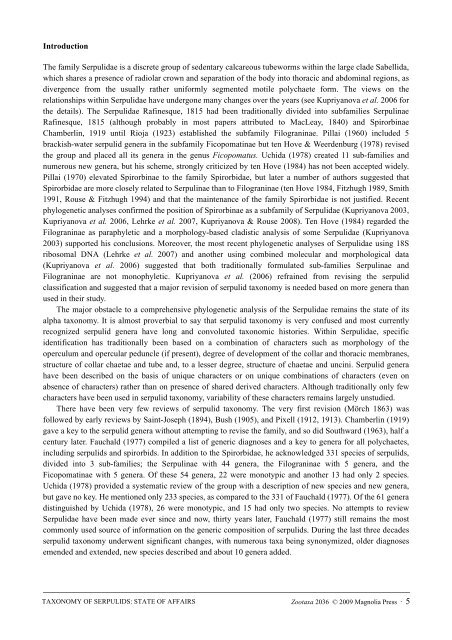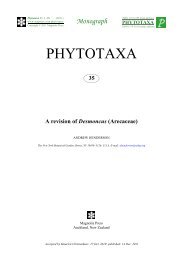Zootaxa, Taxonomy of Serpulidae (Annelida ... - Magnolia Press
Zootaxa, Taxonomy of Serpulidae (Annelida ... - Magnolia Press
Zootaxa, Taxonomy of Serpulidae (Annelida ... - Magnolia Press
Create successful ePaper yourself
Turn your PDF publications into a flip-book with our unique Google optimized e-Paper software.
Introduction<br />
The family <strong>Serpulidae</strong> is a discrete group <strong>of</strong> sedentary calcareous tubeworms within the large clade Sabellida,<br />
which shares a presence <strong>of</strong> radiolar crown and separation <strong>of</strong> the body into thoracic and abdominal regions, as<br />
divergence from the usually rather uniformly segmented motile polychaete form. The views on the<br />
relationships within <strong>Serpulidae</strong> have undergone many changes over the years (see Kupriyanova et al. 2006 for<br />
the details). The <strong>Serpulidae</strong> Rafinesque, 1815 had been traditionally divided into subfamilies Serpulinae<br />
Rafinesque, 1815 (although probably in most papers attributed to MacLeay, 1840) and Spirorbinae<br />
Chamberlin, 1919 until Rioja (1923) established the subfamily Filograninae. Pillai (1960) included 5<br />
brackish-water serpulid genera in the subfamily Ficopomatinae but ten Hove & Weerdenburg (1978) revised<br />
the group and placed all its genera in the genus Ficopomatus. Uchida (1978) created 11 sub-families and<br />
numerous new genera, but his scheme, strongly criticized by ten Hove (1984) has not been accepted widely.<br />
Pillai (1970) elevated Spirorbinae to the family Spirorbidae, but later a number <strong>of</strong> authors suggested that<br />
Spirorbidae are more closely related to Serpulinae than to Filograninae (ten Hove 1984, Fitzhugh 1989, Smith<br />
1991, Rouse & Fitzhugh 1994) and that the maintenance <strong>of</strong> the family Spirorbidae is not justified. Recent<br />
phylogenetic analyses confirmed the position <strong>of</strong> Spirorbinae as a subfamily <strong>of</strong> <strong>Serpulidae</strong> (Kupriyanova 2003,<br />
Kupriyanova et al. 2006, Lehrke et al. 2007, Kupriyanova & Rouse 2008). Ten Hove (1984) regarded the<br />
Filograninae as paraphyletic and a morphology-based cladistic analysis <strong>of</strong> some <strong>Serpulidae</strong> (Kupriyanova<br />
2003) supported his conclusions. Moreover, the most recent phylogenetic analyses <strong>of</strong> <strong>Serpulidae</strong> using 18S<br />
ribosomal DNA (Lehrke et al. 2007) and another using combined molecular and morphological data<br />
(Kupriyanova et al. 2006) suggested that both traditionally formulated sub-families Serpulinae and<br />
Filograninae are not monophyletic. Kupriyanova et al. (2006) refrained from revising the serpulid<br />
classification and suggested that a major revision <strong>of</strong> serpulid taxonomy is needed based on more genera than<br />
used in their study.<br />
The major obstacle to a comprehensive phylogenetic analysis <strong>of</strong> the <strong>Serpulidae</strong> remains the state <strong>of</strong> its<br />
alpha taxonomy. It is almost proverbial to say that serpulid taxonomy is very confused and most currently<br />
recognized serpulid genera have long and convoluted taxonomic histories. Within <strong>Serpulidae</strong>, specific<br />
identification has traditionally been based on a combination <strong>of</strong> characters such as morphology <strong>of</strong> the<br />
operculum and opercular peduncle (if present), degree <strong>of</strong> development <strong>of</strong> the collar and thoracic membranes,<br />
structure <strong>of</strong> collar chaetae and tube and, to a lesser degree, structure <strong>of</strong> chaetae and uncini. Serpulid genera<br />
have been described on the basis <strong>of</strong> unique characters or on unique combinations <strong>of</strong> characters (even on<br />
absence <strong>of</strong> characters) rather than on presence <strong>of</strong> shared derived characters. Although traditionally only few<br />
characters have been used in serpulid taxonomy, variability <strong>of</strong> these characters remains largely unstudied.<br />
There have been very few reviews <strong>of</strong> serpulid taxonomy. The very first revision (Mörch 1863) was<br />
followed by early reviews by Saint-Joseph (1894), Bush (1905), and Pixell (1912, 1913). Chamberlin (1919)<br />
gave a key to the serpulid genera without attempting to revise the family, and so did Southward (1963), half a<br />
century later. Fauchald (1977) compiled a list <strong>of</strong> generic diagnoses and a key to genera for all polychaetes,<br />
including serpulids and spirorbids. In addition to the Spirorbidae, he acknowledged 331 species <strong>of</strong> serpulids,<br />
divided into 3 sub-families; the Serpulinae with 44 genera, the Filograninae with 5 genera, and the<br />
Ficopomatinae with 5 genera. Of these 54 genera, 22 were monotypic and another 13 had only 2 species.<br />
Uchida (1978) provided a systematic review <strong>of</strong> the group with a description <strong>of</strong> new species and new genera,<br />
but gave no key. He mentioned only 233 species, as compared to the 331 <strong>of</strong> Fauchald (1977). Of the 61 genera<br />
distinguished by Uchida (1978), 26 were monotypic, and 15 had only two species. No attempts to review<br />
<strong>Serpulidae</strong> have been made ever since and now, thirty years later, Fauchald (1977) still remains the most<br />
commonly used source <strong>of</strong> information on the generic composition <strong>of</strong> serpulids. During the last three decades<br />
serpulid taxonomy underwent significant changes, with numerous taxa being synonymized, older diagnoses<br />
emended and extended, new species described and about 10 genera added.<br />
TAXONOMY OF SERPULIDS: STATE OF AFFAIRS<br />
<strong>Zootaxa</strong> 2036 © 2009 <strong>Magnolia</strong> <strong>Press</strong> · 5
















